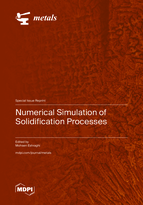Numerical Simulation of Solidification Processes
A special issue of Metals (ISSN 2075-4701). This special issue belongs to the section "Computation and Simulation on Metals".
Deadline for manuscript submissions: closed (30 September 2022) | Viewed by 23513
Special Issue Editor
Special Issue Information
Dear Colleagues,
Solidification is a critical step for many manufacturing processes, including casting, welding, and additive manufacturing. While solidification happens during processing of all types of materials, solidification of metallic alloys has been of utmost importance to scientists and engineers. The importance comes from the fact that the solidification microstructure has a significant influence on the properties of the solidified materials. The kinetics of solidification also determines the distribution of solute atoms, which eventually leads to micro-segregation, secondary phases, and formation of various defects, which exert enormous influence on mechanical properties. By combining the bedrock computational physics and informatics with systematic experiments and advanced manufacturing, we can reduce the cost, risk, and cycle time for new product development. Numerical simulation of solidification processes can help scientists to gain a better understanding of the kinetics governing the macroscopic as well as microscopic features of the solidification process. From an industrial point of view, solidification modeling enables engineers to predict the properties of the material and subsequently modify the process parameters in order to produce materials of higher quality. However, several physical phenomena are involved during the solidification processes that in turn make the simulations very complex. In the wake of promising progress in the area of solidification modeling, this Special Issue embraces studies on numerical simulation of solidification processes ranging from atomistic models to micro-scale and macro-scale process models.
Prof. Mohsen Eshraghi
Guest Editor
Manuscript Submission Information
Manuscripts should be submitted online at www.mdpi.com by registering and logging in to this website. Once you are registered, click here to go to the submission form. Manuscripts can be submitted until the deadline. All submissions that pass pre-check are peer-reviewed. Accepted papers will be published continuously in the journal (as soon as accepted) and will be listed together on the special issue website. Research articles, review articles as well as short communications are invited. For planned papers, a title and short abstract (about 100 words) can be sent to the Editorial Office for announcement on this website.
Submitted manuscripts should not have been published previously, nor be under consideration for publication elsewhere (except conference proceedings papers). All manuscripts are thoroughly refereed through a single-blind peer-review process. A guide for authors and other relevant information for submission of manuscripts is available on the Instructions for Authors page. Metals is an international peer-reviewed open access monthly journal published by MDPI.
Please visit the Instructions for Authors page before submitting a manuscript. The Article Processing Charge (APC) for publication in this open access journal is 2600 CHF (Swiss Francs). Submitted papers should be well formatted and use good English. Authors may use MDPI's English editing service prior to publication or during author revisions.
Keywords
- Solidification
- Numerical Simulation
- Microstructural Evolution
- Phase Transformations
- Dendrite Growth
- Atomistic Modeling
- Phase Field
- Cellular Automata
- Integrated Computational Materials Engineering
- Casting
- Additive Manufacturing






